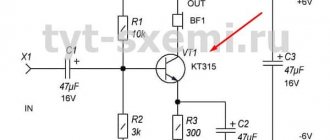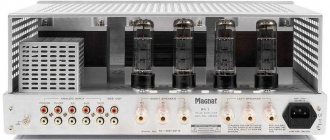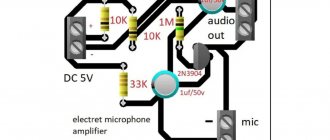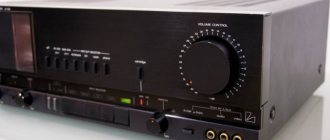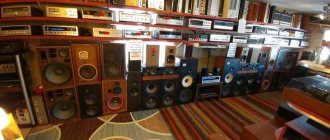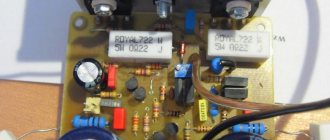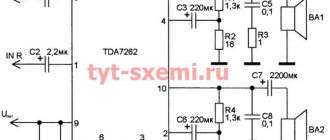A power amplifier is used to drive loudspeakers. Its job is to supply high voltage and high current to a low resistance load over a wide frequency range so as to have minimal signal distortion. The amplifier can be designed as a separate device, or it can be a functional unit as part of a device.
The key indicator of an amplifier's performance is its efficiency, but also an important criterion is the degree of heat generation (the less heat that has to be removed from the amplifier, the better) and the associated power consumption.
A
Everything has its beginning, and if we are talking about amplifier operating modes, the origins are, of course, class A. It is with this that the history of amplifiers in particular and electronic audio in general began.
How a Class A amplifier works, or True High End and a lot of heat Article
Theory and practice Octave amplifiers how the amplifier works
naumov June 28, 2022 at 09:10
98 9
conclusions
To summarize the above, regardless of class, any amplifier can be either bad or good. The result depends not on the class, but on the specific circuit design. Efficiency is an important indicator of an amplifier, and it is the highest in the D-class.
When choosing an amplifier, by and large, you should pay attention to two things: the power output for a given load resistance and the price. Class A/B amplifiers are now the most popular, which is explained by the best balance of the above criteria: they work well at a relatively low cost. Audiophiles remain fans of the A-Class for its clear sound. Professionals with money are increasingly looking at the D-class, after all, its efficiency is significantly higher, and most of them have additional dynamic processing on board - a crossover, an equalizer, a limiter, and even an audio signal delay setting, which is necessary for large installations, where acoustic systems can be located at a distance of about hundreds of meters from the stage. There is no limit to perfection, as well as to the search for new solutions. Therefore, experiment and look for the best solution for your tasks.
AB
From the class AB designation itself, it is easy to conclude that this mode is a hybrid of class A and class B. Until recently, this type of amplifier was used in Hi-Fi equipment many times more often than any other.
How a class AB amplifier works, or Practicality rules the world Article
Theory and practice Amplifiers Atoll how an amplifier works
naumov July 12, 2022 at 09:10
51 6
Sound
The modest-looking Arcam HDA SA20 seemed like a suitable partner only for bookshelf speakers, but this is the case when appearances are 100% deceiving. The amplifier did not change the character of the sound and did not lose control of the bass on acoustics of any complexity. The most powerful and demanding models obeyed his will unquestioningly, producing surprisingly accurate, fast and elastic bass, striking in its combination of density, dynamics and timbral fullness. With the best representatives of classes A and AB, the same speakers produced low frequencies much less focused, and sometimes even tried to smear notes or merge them into a general hum without any specifics.
The mids and highs sounded just as composed and clear, without any pronounced coloration and without distortion, even at high volumes. Live music and vocals were reproduced accurately in both timbre and intonation.
It was not possible to notice any changes in the nature of the sound at different volume levels. The amplifier played with detail and clarity at both low and high volumes. Being exceptionally focused, the Arcam HDA SA20 didn't sound dry or empty. The amplifier simply did not add anything extra to the music. Those recordings that were supposed to sound warm and expressive showed exactly this character, and dry and harsh mixes were not tinted or softened.
The only point that raised some questions was the construction of the scene. It was quite wide, but seemed flat, without any noticeable depth, although the same acoustics with other amplifiers created a much more convincing sense of volume. However, this clearly only means that there is room for experimentation. The main features of class G circuitry were quite obvious and showed themselves in the best possible way. By the way, during testing the Arcam HDA SA20 heated up very moderately.
G.H.
The prerequisite for the creation of class G amplifiers was the fact of nonlinearity of the level of the music signal. Most of the time, music is played at low to medium levels, when the amplifier does not require much power.
How a class “G” and “H” amplifier works, or One step higher Article
Theory and practice Arcam amplifiers how the amplifier works
naumov July 26, 2022 at 09:10
30 8
- Home page
- Amplifiers
- Amplifiers. Amplifier classification
Amplifiers in the catalog
| Integrated amplifiers | Power amplifiers | Preamplifiers |
Amplifier classification
According to the method of working with the input signal and the principle of constructing amplification stages, audio power amplifiers are divided into:
- Analogue, class A
- Analog, class B
- Analog, class AB
- Analogue, class H
- Pulse and digital, class D
It should be noted that there are many more classes of amplifiers, such as C, A+, SuperA, G, DLD, etc. Some of them, such as C (cut-off angle less than 90 degrees) are not used in UMZCH. Others turned out to be too complex and expensive, so they “left the scene” or were replaced by more promising ones.
Analog amplifiers, in fact, differ only in the cutoff angle of the input signal, i.e. choosing the so-called “working point”.
Class A
Cut-off angles for amplifier stages of classes A, B, AB and C.
Class A amplifiers operate without signal cutoff in the most linear section of the current-voltage characteristic of the amplifying elements. This ensures a minimum of nonlinear distortions (THD and IMD), both at rated power and at low powers.
For this minimum you have to pay with impressive power consumption, size and weight. On average, the efficiency of a class A amplifier is 15-30%, and the power consumption does not depend on the output power. Power dissipation is maximum at small output signals.
Interesting representatives of class A amplifiers are the transistor Pass Labs XA 200.5 and the tube Unison Research Sinfonia, the comparative characteristics of which are given in the table:
| Characteristics | Pass Labs XA 200.5 | Unison Research Sinfonia |
| Rated power | 200 W | 25W |
| Harmonic Distortion Factor | 1% (400W) | not specified |
| Frequency range | 1.5 – 100000 Hz | 20 – 30000 Hz |
| Power consumption | 700 W | 500 W |
| Weight | 81 kg | 25 kg |
Representative of Class A amplifiers
Class B
The operating principle of amplifiers, classes A, B and C.
The reinforcing elements operate with a cutoff of 90 degrees. To ensure this mode of operation of the amplifier, a push-pull circuit is used, where each part of the circuit amplifies its “half” of the signal. The main problem with amplifiers in class B is the presence of distortion due to a stepwise transition from one half-wave to another. Therefore, at low input signal levels, nonlinear distortion reaches its maximum.
Step-type distortion in class B amplifiers.
The advantage of a class B amplifier can be considered high efficiency, which theoretically can reach 78%. The power consumption of the amplifier is proportional to the output power, and in the absence of a signal at the input it is generally zero. Despite the high efficiency, it is unlikely that anyone will be able to find class B amplifiers among modern models.
Class AB
As the name suggests, class AB amplifiers are an attempt to combine the advantages of class A and class B amplifiers, i.e. achieve high efficiency and an acceptable level of nonlinear distortion. In order to get rid of the step transition when switching amplifier elements, a cutoff angle of more than 90 degrees is used, i.e. the operating point is selected at the beginning of the linear section of the current-voltage characteristic. Due to this, in the absence of a signal at the input, the amplifying elements are not switched off, and some quiescent current flows through them, sometimes significant. Because of this, the efficiency decreases and a minor problem arises in stabilizing the quiescent current, but nonlinear distortions are significantly reduced.
Among analog amplifiers, this operating mode is most common. Graphs of the dependence of nonlinear distortion factors on the output power of the amplifier for classes A, B and AB.
Minimizing step distortion in class AB amplifiers.
Comparative table of amplifiers operating in modes A, B, AB:
| Characteristics | A | B | AB |
| Theoretical efficiency | 50% | 78% | Depends on mode |
| Real efficiency | 15-30% | 50-60% | 40-50% |
| Nonlinear distortion | small | High | average) |
| Power consumption | constant | depends on holiday | depends on holiday |
| Thermal stability | low | high | average |
Representative of class AB amplifiers
Class H
This class of amplifiers was developed specifically for cars in which there is a limitation of the voltage supplying the output stages. The impetus for the creation of class H amplifiers was the fact that the real audio signal is pulsed in nature and its average power is much lower than the peak power. The circuit is based on a conventional class AB amplifier connected in a bridge circuit. The highlight is the use of a special circuit for doubling the supply voltage. The main element of the doubling circuit is a large-capacity storage capacitor, which is constantly recharged from the main power source. At power peaks, this capacitor is connected by the control circuit in series with the main power source. The supply voltage of the amplifier's output stage doubles for a fraction of a second, allowing it to cope with the transmission of signal peaks. However, the storage capacitor must be of sufficient capacity, otherwise the declared output power will be provided only at medium and high frequencies.
The idea of switching supply voltage has found application not only in car power amplifiers. An amplifier with two or three levels of power supply is actually a pulse amplifier with a serial analog channel, which converts excess pulse energy into heat. The more steps the supply voltage has, the closer to a sine wave the ladder at the output of the pulse part of the amplifier is obtained and the less heat is generated on the analog channel.
Amplifiers built using similar circuitry combine discrete amplification methods with analog ones and, accordingly, occupy an intermediate position between analog and pulse amplifiers in terms of efficiency and heat dissipation. In this amplifier, to increase efficiency and, accordingly, reduce heat dissipation, a discrete approximation of the analog channel supply voltage level to its output voltage is used. The increase in efficiency occurs due to a decrease in the voltage drop on the active arm compared to amplifiers with single-level power supply. A distinctive feature of such amplifiers is that switching of key elements occurs with the signal frequency. Filtering of higher harmonics is carried out by the analog part of the amplifier by converting harmonic energy into heat in amplifiers with a high clock frequency, when the switching frequency of key elements is many times higher than the upper limit frequency of the signal, and filtering is carried out by an LC filter. Thermal losses of the analog part of the amplifier are quite low, but they are sufficiently compensated by switching losses and losses in the filter at high clock frequencies. There is an optimal number of supply voltage steps at which the complexity of the circuit is justified by an increase in efficiency and a reduction in the cost of powerful transistors in the analog part of the amplifier. The efficiency of Class H amplifiers reaches 83% with a harmonic distortion coefficient of 0.1%.
Class D
Strictly speaking, class D is not only a construction scheme or operating mode of the output stage - it is a separate class of amplifiers. It would be more logical to call them pulsed, but the historical name “digital” is already firmly attached to them. Let's consider the general block diagram of the amplifier.
Block diagram of a digital amplifier
The digitized signal is sent to the audio processor, which in turn, using pulse width modulation (PWM - Pulse Width Modulation), controls the power semiconductor switches. It can be added that a PWM signal can be obtained without analog-to-digital conversion using a comparator and a generator, for example, a sawtooth signal. This method is also widely used in class D amplifiers, but thanks to the development of digital technology it is gradually becoming a thing of the past. Analog-to-digital conversion provides additional sound processing capabilities: from adjusting volume and timbre to implementing digital effects such as reverberation, noise reduction, acoustic feedback suppression, etc.
Unlike analog amplifiers, the output of Class D amplifiers is a square wave. Their amplitude is constant, but their duration (“width”) varies depending on the amplitude of the analog signal entering the amplifier input. The pulse frequency (sampling frequency) is constant and, depending on the requirements for the amplifier, ranges from several tens to hundreds of kilohertz. After formation, the pulses are amplified by terminal transistors operating in switching mode. Conversion of the pulse signal to analog occurs in a low-pass filter at the output of the amplifier or directly in the load.
Graph of the efficiency of analog and digital amplifiers versus output power.
In general, the principle of operation of a class D amplifier is very similar to the principle of operation of a switching power supply, but unlike it, at the output, due to pulse width modulation, not a constant voltage is generated, but an alternating one, in shape corresponding to the input signal.
Theoretically, the efficiency of such amplifiers should reach 100%, but, unfortunately, the resistance of the transistor channel, although small, is still non-zero. But, nevertheless, depending on the load resistance, the efficiency of amplifiers of this type can reach 90% -95%. Of course, with such efficiency, there is virtually no heating of the output transistors, which makes it possible to create very small and economical amplifiers. With proper design of the output filter, the harmonic distortion coefficient can be increased to 0.01%, which is an excellent result. Distortion increases as the signal frequency increases and the sampling rate decreases. The output power also depends indirectly on the sampling frequency - as the frequency increases, the inductance of the coils decreases and the losses in the output filter decrease.
Like analog amplifiers, switching amplifiers are divided into subclasses AD and BD, and their advantages and disadvantages are also similar. In class AD amplifiers, in the absence of an input signal, the output stage continues to operate, delivering multipolar pulses of the same duration to the load. This improves the quality of transmission of weak signals, but significantly reduces efficiency and gives rise to a number of technical problems. In particular, you have to deal with the so-called through current, which occurs when the output transistors switch simultaneously. To eliminate the through current in the output stage, a dead time is introduced between the closing of one transistor and the opening of the other.
Practical applications are found in simpler designs: class BD amplifiers, the output stage of which, in the absence of a signal, generates pulses of very short duration or is at rest. However, in amplifiers of this type, the main drawback is most pronounced - the dependence of the level of nonlinear distortion on the sampling frequency and signal frequency. In addition, distortion increases with small input signals. Most often, class D amplifiers, like class AB, are produced in an integrated design.
Such amplifiers are used in public address and broadcast systems, which, as is known, do not pay much attention to achieving special sound quality. In professional audio reproduction systems in class D, amplifiers for subwoofers are mainly implemented, since at low frequencies the ear is least sensitive to nonlinear signal distortions.
If previously an amplifier simply required reliable operation and guaranteed sound quality, modern models are complemented by a number of service functions, such as computer control of the amplifier, programming of the built-in limiter, and the presence of a digital input. With cheaper digital interfaces for transmitting audio signals, we can expect a growth in the market for amplifiers with remotely controlled parameters and automatic diagnostics, which will certainly expand the possibilities for creating sound reinforcement systems. Considering the rapid development of digital technology and the element base, it is difficult to even imagine to what heights further improvement of the principles of constructing power amplifiers will lead us.
Representative of Class D amplifiers
XD/XA
The zero point is the most vulnerable point in a musical signal, and, despite all the bias tricks produced in the AB class, it is still much better when the zero point of the signal is reproduced by one transistor, and its gate does not balance on the verge of opening or closing.
How an XD and XA class amplifier works, or a little exotic Article
Theory and practice Cambridge Audio amplifiers how an amplifier works
naumov August 09, 2022 at 09:10
24 5
D
In the world of Hi-Fi, class D has the hardest fate, and its development did not occur due to objective advantages, but rather contrary to prevailing opinion. It all started with the fact that class D was literally immediately given the offensive, in the opinion of some audiophiles, label “digital amplifier”. And although some of the principles of its operation do resemble the operation of digital circuits, at its core it is a completely analog device.
How a Class D amplifier works, or Not like everyone else Article
Theory and practice Marantz amplifiers how an amplifier works
naumov August 23, 2022 at 09:10
88 10
General principles of amplifier design
In a nutshell, an amplifier consists of a sequence of amplification stages connected to each other. Although there are also single-stage amplifiers. An amplification stage is an amplifier stage consisting of one or more amplification elements, a load circuit and connections to other stages. Amplification elements can be represented by vacuum tubes, transistors and even tunnel diodes.
In addition to direct interstage connections, there are also negative feedback connections, which make the operation of the amplifier more stable and reduce the degree of signal distortion. For this purpose, amplifiers use, for example, thermistors to stabilize the temperature during operation of the amplifier or frequency-dependent components that equalize a particular characteristic.
Also between the amplifier stages, in the input and output circuits, attenuators or potentiometers can be used to regulate the degree of signal amplification, and filters to regulate and set the frequency response.
Amplifiers can be divided into analog and digital. Obviously, in analog devices, the input signal is amplified by analog stages and is not subject to further digitization, remaining analog at the output. In digital amplifiers, the analog input signal, after analog amplification, is subjected to analog-to-digital conversion, and the output signal is already digital.
LAMP!
Gain classes are a completely logical and understandable way to distinguish one typical circuit from another. However, when applied to tube circuitry, this approach turned out to be insufficient.
How tube amplifiers work, or Features of a warm sound Article
Amplifiers Theory and practice Cayin how an amplifier works
naumov September 06, 2022 at 09:10
20 5
The selection was prepared with the support of , the amplifiers were tested in the listening rooms of the salon
